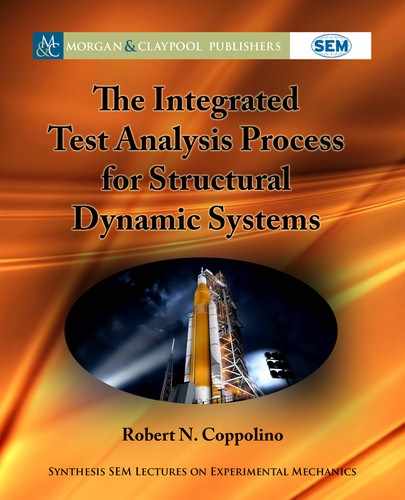
2.2. PART 2: GUIDELINES FOR SYSTEMATIC MODEL DEVELOPMENT 31
Shell breathing modes mapped for:
1. Empty, un-pressurized
2. Empty pressurized
3. Half-filled with water, un-pressurized
Z
t = 0.0813 CM
t = 50.8 CM
R = 25.4 CM
1.27 CM
P
0
- Internal
Pressure
0.0813 CM Lip (Top & Bottom)
0.635 CM
0.635 CM
1.587 CM
1.905 CM
1.905 CM
1.905 CM
50.8 CM Diameter
50.8 CM
Resistance Weld
Bottom Plate ickness Varies
From 1.905 CM at Outer Edge
to 1.27 CM at C/L
Resistance Weld
Figure 2.12: NASA Langley Research Center cylindrical shell test article.
shell breathing modes for the initial models were significantly higher than all corresponding
test data. After changing the model end boundary conditions to pinned (shear diaphragm),
which was not intuitively obvious to the young engineer (this book’s author), all of the analytical
natural frequencies closely followed modal test data, as illustrated in Figure 2.13.
is lesson, experienced by many young engineers, is a clear example of non-ideal bound-
ary conditions that exist in real structures. It is most unfortunate that this point is so easily missed
by many practicing engineers due to the high degree of automation in day-to-day utilization of
today’s computer-aided engineering (CAE) tools.
2.2.16 DAMPING IN STRUCTURAL ASSEMBLIES
Most engineering organizations employ empirically based values for modal damping (
n
), and
the modal approach for description of “viscous” damping, when practical, which circumvents
difficulties associated with the lack of a theoretical damping matrix.
A variety of artificially constructed mathematical forms for the damping matrix have been
defined over the past century. One form that has managed to find its way into most finite element

32 2. DEFINITION OF TEST ARTICLE FINITE ELEMENT MODELS
Z
t = 0.0813 CM
Mode Shape Functions:
wIZ 01 = wIZ cos nP
t = 50.8 CM
R = 25.4 CM
1.27 CM
P
0
- Internal
Pressure
Legend
△ Test
□ Anal. (w =
|CL-CL|
Anal. (w =
—
= 0)
NZ = 0 z = 0 l
2w
3Z
500
400
300
200
700
600
500
400
300
200
100
0
4 6 8 10 12
4 6 8 10 12 4 6 8 10 12
Empty
P
0
= 0
Empty
P
0
= 5.516 × 10
4
N/M
2
½ Full Water
P
0
= 0
f|HZ|
f|HZ|
f|HZ|
n
n n
Figure 2.13: Comparison of predicted and measured shell breathing mode frequencies.
codes, namely proportional damping, which is attributed to Rayleigh [21], is
Œ
B
D ˛
Œ
M
C ˇ
Œ
K
: (2.57)
Application of the modal transformation on this matrix form results in the following
distribution of modal damping, which does not resemble typical empirical data records:
n
D
˛
2!
n
C
ˇ!
n
2
: (2.58)
While proportional damping constructs a mathematically elegant approach for computa-
tional structural dynamics, it is never consistent with experimental data, and merits abandon-
ment.
During the late 1920s, Kimball and Lovell [22] and Becker and Foppl [23], independently
determined by experiment, that damping in typical structures is simultaneously proportional to
displacement (strain) and in phase with velocity, Shortly thereafter, Kussner [24] and Kass-
ner [25] introduced the concept of complex structural damping, which appropriately describes
..................Content has been hidden....................
You can't read the all page of ebook, please click here login for view all page.
